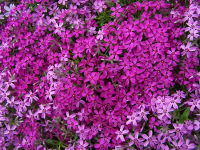Phlox subulata
| Standard Cyclopedia of Horticulture |
|---|
|
Phlox subulata, Linn. (P. setacea, Linn.). Ground Pink. Moss Pink. Fig. 2915. Tufted or matted species, in many forms, the depressed sts.more or less pubescent: lvs. crowded or fascicled (except on the flowering sts.), narrow-linear to linear-lanceolate, very sharp and usually stiff, ciliate: fls. nearly 1 in. across, light blue, pink or white, in small clusters standing 2-6 in. above the ground, the lobes obcordate or entire. Dry banks and fields, N. Y., west and south, reaching Fla.; run wild in patches along many roadsides, in cemeteries, and elsewhere. B. M. 411 and 415. Gn. 67, p. 218; 71, p. 166; 75, p. 29. F. W7 1878, frontis. Gn. M. 2:167. G.L.22: 358.—A much-prized old garden plant, useful for colonizing where it is desired to cover the earth with a mat. It blooms profusely in spring. The garden forms are many, as: Var. nivalis, Hort. (P. nivalis, Lodd.), white-fld., style short; ovules commonly 2 or 3 in each cell. L. B.C. 8:780. Var. aristata, Hort. (P. aristata, Lodd.), has fls. pure white, sometimes lilac-tinted; ovules 1 in each cell. L.B.C. 18:1731. Var. Nelsonii, Hort., (not P. Nelsonii, Brand), white, with rose-red eye; compact. G.W. 15, p. 430. Gn. 75, p. 275. Var. Hentzii, Voss (P, Hentzii, Nutt.), lobes entire or nearly so, white, lavender or purple. Southern states. Var. annulata, Hort., whitish blue, with purple ring. Var. atropurpurea, Hort., rose-purple with crimson ring. Var. grandiflora, Hort., fls. large, red; plant dwarf. Var. stellaris, Hort., with star-like white fls. in profusion. Var. caerulescens, Hort., with bluish fls. Var. pallida. Hort., large-fld., rose-colored shaded lilac. Var. frondosa, Hort., vigorous form; fls. pink with dark center. Var. lilacina, Hort., compact, lilac-fld. G.C. III. 41:383. G.M. 55:283.—Some of the foregoing forms are described or listed as if derived from P. Stel- laria; but whether from the species P. Stellaria, Gray, or the race of stelliaria or stellaris of P. subulata, is not always clear.
|
| Moss Phlox {{{status}}} Fossil range: {{{fossil_range}}}
| ||||||||||||||||||||||||||||||||||||||||||||||||||||||||||||||||||
|---|---|---|---|---|---|---|---|---|---|---|---|---|---|---|---|---|---|---|---|---|---|---|---|---|---|---|---|---|---|---|---|---|---|---|---|---|---|---|---|---|---|---|---|---|---|---|---|---|---|---|---|---|---|---|---|---|---|---|---|---|---|---|---|---|---|---|
 | ||||||||||||||||||||||||||||||||||||||||||||||||||||||||||||||||||
| Plant Info | ||||||||||||||||||||||||||||||||||||||||||||||||||||||||||||||||||
| ||||||||||||||||||||||||||||||||||||||||||||||||||||||||||||||||||
| Scientific classification | ||||||||||||||||||||||||||||||||||||||||||||||||||||||||||||||||||
| ||||||||||||||||||||||||||||||||||||||||||||||||||||||||||||||||||
| [[{{{diversity_link}}}|Diversity]] | ||||||||||||||||||||||||||||||||||||||||||||||||||||||||||||||||||
| {{{diversity}}} | ||||||||||||||||||||||||||||||||||||||||||||||||||||||||||||||||||
| Binomial name | ||||||||||||||||||||||||||||||||||||||||||||||||||||||||||||||||||
| Phlox subulata L. | ||||||||||||||||||||||||||||||||||||||||||||||||||||||||||||||||||
| Trinomial name | ||||||||||||||||||||||||||||||||||||||||||||||||||||||||||||||||||
| {{{trinomial}}} | ||||||||||||||||||||||||||||||||||||||||||||||||||||||||||||||||||
| Type Species | ||||||||||||||||||||||||||||||||||||||||||||||||||||||||||||||||||
| {{{type_species}}} | ||||||||||||||||||||||||||||||||||||||||||||||||||||||||||||||||||
| {{{subdivision_ranks}}} | ||||||||||||||||||||||||||||||||||||||||||||||||||||||||||||||||||
| [[Image:{{{range_map}}}|{{{range_map_width}}}|]] | ||||||||||||||||||||||||||||||||||||||||||||||||||||||||||||||||||
| Synonyms | ||||||||||||||||||||||||||||||||||||||||||||||||||||||||||||||||||
| {{{synonyms}}} |
Phlox subulata [1] (Moss Phlox, Moss Pink, Mountain Phlox) is a perennial creeper growing to a height of 6 inches and covering a 20 inch wide area. The small, five-petaled flowers bloom in rose, mauve, blue, white, or pink in late spring to early summer.
Cultivation[2][3]
- Requires full sun and well-drained soil.
- Hardiness zones: USDA zone 3 to 9
Notes
References
- Blanchan, Neltje (2002). Wild Flowers: An Aid to Knowledge of our Wild Flowers and their Insect Visitors. Project Gutenberg Literary Archive Foundation.
- Bay Books. P. 2005. The A-Z of Garden Flowers.